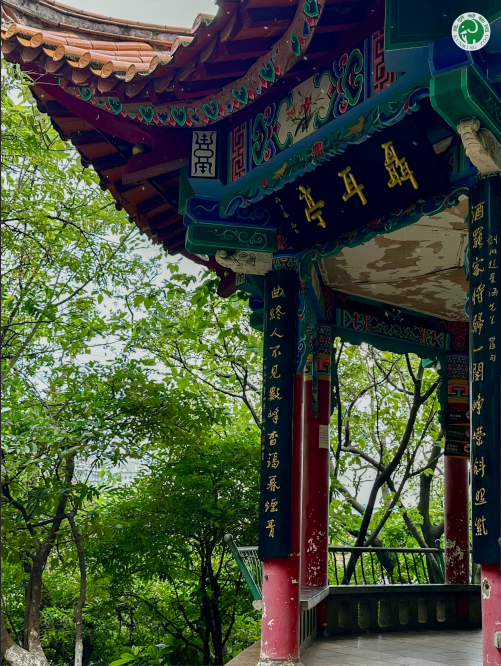Beyond Cute Animals & Cherry Blossoms: Yuantong Mountain's Ancient Pavilions Hold Half of Kunming's History
来源:InKunming时间:2025-07-29 15:07:13
Hey everyone! Do you only think of seeing animals and enjoying cherry blossoms when you visit Yuantong Mountain?
Then you're missing out on so many treasures!
Come follow my lead and let's unlock Yuantong Mountain's hidden gems together!
A Pilgrimage to Nine Historic Pavilions
These buildings with their upturned eaves and ornate corners
aren't just fantastic photo backdrops –
they're also treasure troves of Kunming's historical and cultural legacy.
Today, let's step inside the Nie Er Pavilion
and the Martyrs Memorial Pavilion,
uncovering the stories behind them.
Nie Er Pavilion
Perched atop a cliff on the southern slope of Yuantong Mountain, a single-eaved, hexagonal pavilion stands serenely: the Nie Er Memorial Pavilion, built to honor the people's musician, Nie Er.

Born in Kunming and originally from Yuxi, Nie Er composed over 30 patriotic and revolutionary songs, including the official national anthem of the People's Republic of China, "March of the Volunteers," in his short 23 years.
The Nie Er Pavilion was built in 1936 through donations from figures in Yunnan's literary and art circles, including Chu Tunan, Feng Sutao, Xu Jiarui, and Zhao Shiming. It was renovated in 1955 and is a renowned historical and cultural pavilion in Kunming. The couplet inside the pavilion, loosely translated as "The guest departs after drinks, a majestic pavilion in the purple afterglow; The melody ends, the figure disappears, misty peaks in the evening haze," encapsulates the boundless mourning of his close friends.
Standing in the pavilion and gazing into the distance, you can almost hear the melodies echoing across time.
Martyrs Memorial Pavilion
Built in 1914 and located east of the Luofeng Pavilion, the Martyrs Memorial Pavilion is a single-eaved, hexagonal pavilion with a pyramidal roof, commemorating Huang Yuying, to whom Sun Yat-sen inscribed the words "Qian Kun Zheng Qi (Righteousness Between Heaven and Earth)."
Huang Yuying, from Huize, was a revolutionary during the Xinhai Revolution (1911 Revolution). After studying in Japan in his early years, he participated in planning the Kunming Double Ninth Uprising in 1911, firing the first shot of the uprising and claiming "first merit in the restoration of Yunnan." This 28-year-old martyr was honored with an epitaph personally written by Cai' E and a plaque inscribed by Sun Yat-sen himself.
After Huang Yuying's sacrifice, he was buried south of the Luofeng Pavilion on Yuantong Mountain. In 1914, a bronze statue of Huang Yuying was erected in the Martyrs Temple (now the Lianyun Hotel) on the southern foothills of the mountain. Later, the former Jinzhong Temple on the back street of the then Quanye Market was renovated into the "Huang Wuyi Ancestral Hall" dedicated to Huang Yuying. In his honor, the Kunming Dongfeng Elementary School located within the Huang Ancestral Hall was renamed "Yuying Elementary School."
Besides these two major historical pavilions, Yuantong Mountain also boasts the Observation Pavilion, Moon Stone Pavilion, Naxia Pavilion, Loyalty and Filial Piety Pavilion, Luofeng Pavilion, Morality and Education Pavilion, Huize Pavilion, and other treasure-filled pavilions waiting for you to explore.
The pavilions stand in silence, yet they carry the historical and cultural memories of Kunming. When you come to Yuantong Mountain, be sure to step into the mountain pavilions, touch the carvings on the plinths, and look up at the inscriptions between the plaques. When the melodies composed by Nie Er and the trigger pulled by Huang Yuying overlap with the sound of your footsteps, that's when you experience Kunming's most vivid history lesson.
各位小伙伴来圆通山是不是只知道看动物、赏樱花?
那你可错过太多宝藏啦!
快跟随小编的脚步
一起解锁圆通山隐藏玩法
九大历史亭阁巡礼
这些飞檐翘角的建筑
不仅是绝佳拍照背景
更是昆明历史文化的宝藏打卡点
今天就让我们走进
聂耳亭和忠烈碑亭
了解它们背后的故事
聂耳亭
在圆通山南坡的绝壁之上,一座单檐六角亭静静伫立,这就是为人民音乐家聂耳建造的纪念亭。
聂耳,原籍玉溪,生于昆明,在他23年的短暂生命中,创作了包括中华人民共和国国歌《义勇军进行曲》在内的30多首爱国歌曲和革命歌曲。
聂耳亭于1936年由楚图南、冯素陶、徐嘉瑞、赵式铭等在云南文艺界发起捐资修建,1955年重修,是昆明的历史文化名亭。亭联“酒罢客将归,一阁峥嵘斜照紫;曲终人不见,数峰杳霭暮烟青”,充满了挚友们对他的无限追思。
站在亭中远眺,仿佛能听见穿越时空的旋律。
忠烈碑亭
忠烈碑亭建于1914年,位于螺峰阁东面。这座单檐六角攒尖亭,纪念的是孙中山为其题字“乾坤正气”的黄毓英。
黄毓英,会泽人,辛亥志士,早年留学日本,1911年参与策动昆明重九起义,打响起义第一枪,立下云南“光复首功”。这位28岁牺牲的志士,获蔡锷亲自撰写墓志铭,孙中山挥毫题匾。
黄毓英牺牲后,被安葬在圆通山螺峰阁南面,1914年在山之南麓(今连云宾馆)忠烈祠塑黄毓英铜像,后又在当年劝业场后街将原尽忠寺改建“黄武毅公祠”,专祀黄毓英。为纪念黄毓英,在黄公祠内的昆明东风小学被更名为“毓英小学”。
除了这两大历史名亭,圆通山还有瞭望亭、月石亭、衲霞亭、忠孝碑亭、螺峰阁、德教碑亭、会泽亭等宝藏亭阁等你探寻。
亭不语,却承载着昆明城的历史文化记忆。来圆通山,不妨走进山间亭阁,触摸柱础上的雕花,仰望匾额间的题字。当聂耳谱写的旋律、黄毓英扣动的扳机声,与你的脚步声重叠,这才是昆明最生动的历史课。











